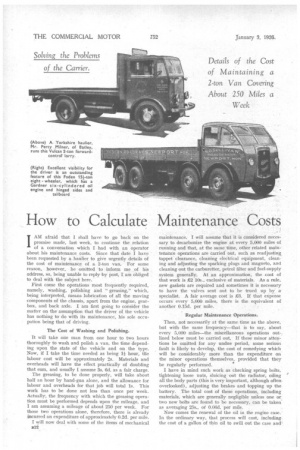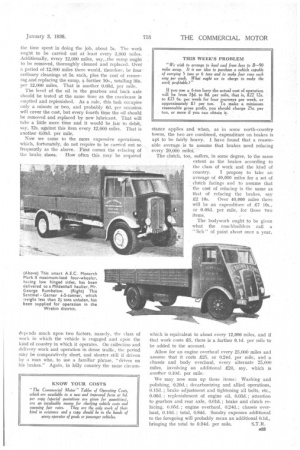How to Calculate Maintenance Costs
Page 32

Page 33

If you've noticed an error in this article please click here to report it so we can fix it.
Details of the Cost of Maintaining a 2-ton Van Covering About 250 Miles a Week IAM afraid that I shall have to go back on the promise made, last week, to continue the relation of a conversation which I had with an operator about his maintenance costs. Since that date I have been requested by a haulier to give urgently details of the cost of maintenance of a. 2-ton van. For some reason, however, he omitted to inform me of his address, so, being unable to reply by post, I am obliged to deal with the subject here.
First come the operations most frequently required, namely, washing, polishing and "greasing," which, being interpreted, means lubrication of all the moving components of the chassis, apart from the engine, gearbox, and back axle. I am first going to consider the matter on the assumption that the driver of the vehicle has nothing to do with its maintenance, his sole occupation being that of driving.
The Cost of Washing and Polishing.
It will take one man from one hour to two hours thoroughly to wash and polish a van, the time depending upon the state of the vehicle and on the type. Now, if I take the time needed as being 1i hour, the labour cost will be approximately 2s. Materials and overheads will have the effect practically of doubling that sum, and usually I assume 3s, 6d. as a fair, charge.
The greasing, to be done properly, will take about half an hour by hand-gun alone, and the allowance for labour and overheads for that job will total 1s. This work has to be done not less than once per week. Actually, the frequency with which the greasing operation must be performed depends upon the mileage, and I am assuming a mileage of about 250 per week. For those two operations alone, therefore, there is already incurred an expenditure of approximately 0.2d. per mile.
I will now deal with some of the items of mechanical _ B22
maintenance. I will assume that it is considered necessary to decarbonize the engine at every 5,000 miles of running and that, at the same time, other related maintenance operations are carried out, such as readjusting, tappet clearance, cleaning electrical equipment, cleaning and adjusting the sparking plugs and magneto, and cleaning out the carburetter, petrol filter and fuel-supply system generally. At an approximation, the cost of that work is £2 10s., exclusive of materials. As a rule, new gaskets are required and sometimes it is necessary to have the valves sent out to be trued up by a, specialist. A fair average cost is £3. If that expense occurs every 5,000 miles, there is the equivalent of another 0.15d. per mile.
Regular Maintenance Operations.
Then, not necessarily at the same time as the above, but with the same frequency—that is to say, about every 5,0(X) miles—the miscellaneous operations outlined below must be carried out. If these minor attentions be omitted for any undue period, some serious fault is likely to develop, the cost of remedying which will be considerably more than the expenditure on the minor operations themselves, provided that they be regularly performed.
I have in mind such work as checking spring bolts, tightening loose nuts, sluicing out the radiator, oiling all the body parts (this is very important, although often overlooked), adjusting the brakes and topping up the battery. The total cost of these operations, including materials, which are generally negligible unless one or two new bolts are found to be necessary, can be taken' as averaging 25s., of 0.00d. per mile.
Now comes the renewal of the oil in the engine case.. In the ordinary way, that process will cost, including, the cost of a gallon of thin oil to swill out the case and
the time spent in doing the job, about 5s. The work ought to be carried out at least every 3,000 miles. Additionally, every 12,000 miles, say,,the sump ought lo be removed, thoroughly cleaned and replaced. Over a period of .12,000 -miles there would, therefore, be fourordinary cleanings at 5s. each, plus the cost of removing,and replacing the sump, a, further 10s., totalling 30s. per 12,000 miles. That is another 0.03d. per mile.
The level of the oil in the gearbox and back axle should be tested at the same time as the crankcase is emptied and replenished. As a rule, this task occupies only a minute or two, and probably 6d. per occasion will cover the cost, but every fourth time the oil should be removed and replaced by new lubricant. That will take a little more time and it would be ,fair to debit, say, 12s. against this item every 12,000 miles. That is another 0.01d. per mile.
Now we come to the more expensive operations, which, fortunately, do not require to be carried out so frequently as the above. First comes the refacing of
the brake shoes. How often this may. be required
depends much upon two factors, namely, the class of work in which the vehicle is engaged and upon the kind of country in which it operates. On collection and delivery work and operation in dense traffic, the period may be comparatively short, and shorter still if driven by a man who, to use a familiar phrase, "drives on his brakes." Again, in hilly country the same circum
stance applies and, when, as in some north-country towns, the two are combined, expenditure on brakes is apt to be fairly heavy. I have found that a reasonable average is to assume that brakes need refacing every 20,000
The clutch, too, suffers, in some degree, to the same extent as the brakes according to the class of work and the kind of country. I propose to take an average of 40,000 miles for a set of clutch facings and to assume that the cost of refacing is the same as that of refacing the brakes, say .£2 10s. Over 40,000 miles there will he an expenditure of 10s., or 0.05d. per mile, for those two items.
The bodywork ought to be given
• what the coachbuilders call a " lick " of paint about once a year,
which is equivalent to about every 12,000 miles, and if that work costs £5, there is a further 0_1d. per mile to be added to the account.
Allow for an engine overhaul every 25,000 miles and assume that it costs £25, or 0.24d. per mile, and a chassis and body overhaul, every alternate 25,0()0 miles, involving an additional 220, say, which is another 0.10d. per mile.• We may now sum up these items ; Washing and polishing, 0.20d.; decarbonizing and allied operations, 0.15d. ; brake adjustment and tightening all bolts, etc., 006d.; replenishment of engine oil, 0.03d.; attentiOn to gearbox and rear axle, 0.01d.; brake and clutch refacing, 0.05d. ; engine overhaul, 0.24d, ; chassis overhaul, 0.10d. ; total, 0.84d. Sundry expenses additional to the foregoing will probably mean an additional 0.1d., bringing the total to 0.94d. per mile. S.T.R.




















































































